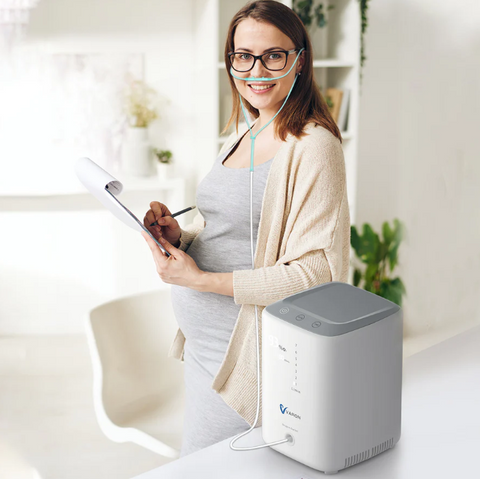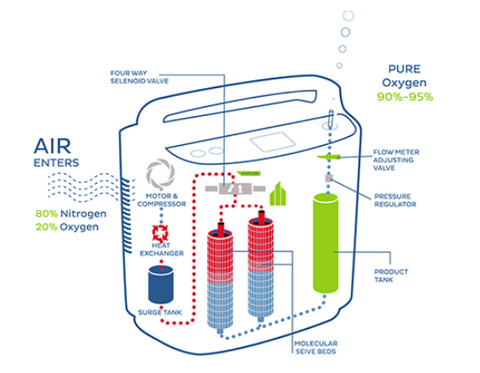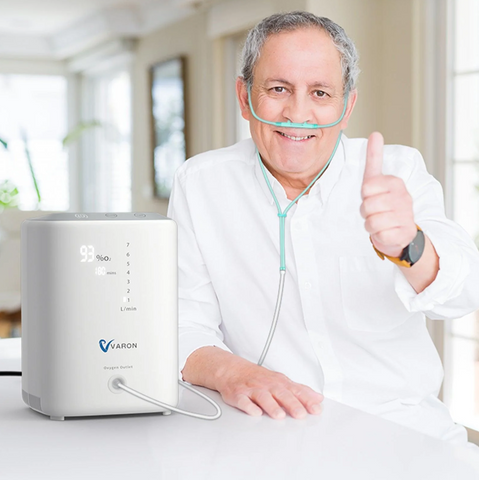
The Environmental Impact of Oxygen Concentrators: Evaluating Sustainability for Home and Portable Use
In today's healthcare landscape, oxygen concentrators have become a vital tool for managing respiratory conditions. These devices, unlike traditional oxygen tanks, work by drawing in ambient air, separating the oxygen from nitrogen, and delivering a concentrated stream of oxygen to patients experiencing breathing difficulties. While oxygen concentrators play a crucial role in improving patient lives, it's important to consider their environmental impact.
Don't search further for oxygen concentrators nearby, as a company dedicated to responsible manufacturing and sustainability, VARON aims to provide patients with home oxygen concentrators and portable oxygen concentrators that minimize their environmental footprint.
This blog post will delve into the environmental considerations of oxygen concentrators, exploring their energy consumption, how does oxygen concentrators work, and potential ways to mitigate their environmental impact.
What is an Oxygen Concentrator?
An oxygen concentrator is a health care device that takes in ambient air, which is about 20% oxygen and 80% nitrogen, and separates the nitrogen from the oxygen. Through a process called Pressure Swing Adsorption (PSA), the oxygen concentrator delivers a much higher concentration of oxygen, typically around 90-95%, to the patient. This enriched oxygen is then delivered through a nasal cannula or mask, helping people breathe easier and improve their blood oxygen levels.
Types of Oxygen Concentrators
There are two main types of oxygen concentrators:

- Home Oxygen Concentrators: These are stationary units designed for continuous use at home. They are typically larger and more powerful than portable models.

- Portable Oxygen Concentrators: These are lightweight and compact, allowing patients to take their oxygen source with them during daily activities or travel.
How Does Oxygen Concentrators Work

Oxygen concentrators utilize a technology called Pressure Swing Adsorption (PSA). Here's a breakdown of the process:
- Air Intake: The oxygen concentrator draws in ambient air through a filter system to remove dust and other contaminants.
- Compression: An air compressor pressurizes the filtered air.
- Molecular Sieve Beds: The compressed air is directed through two zeolite-filled canisters called molecular sieve beds. Zeolite is a mineral with a porous structure that has a high affinity for nitrogen molecules.
- Adsorption and Release: As the compressed air passes through one sieve bed, the zeolite adsorbs nitrogen molecules, allowing oxygen to pass through more freely. The other sieve bed goes through a depressurization cycle, releasing the adsorbed nitrogen back into the environment.
- Oxygen Delivery: The concentrated oxygen stream exits the sieve beds and is delivered to the patient via a nasal cannula or mask.
This cycle repeats continuously, providing a steady flow of oxygen to the patient. It's important to note that oxygen concentrators don't create oxygen; they simply separate it from the existing oxygen already present in the air.
Environmental Considerations: Energy Consumption and Efficiency
One of the primary environmental concerns surrounding oxygen concentrators is their energy consumption. These devices require a constant power supply to function, and depending on the model, their power draw can vary. Here are some factors affecting an oxygen concentrator's energy consumption:
- Flow Rate: The amount of oxygen delivered per minute (flow rate) significantly impacts energy use. Higher flow rates require more power to maintain.
- Technology: Advancements in technology have led to the development of more energy-efficient oxygen concentrators. VARON prioritizes energy efficiency in its home oxygen concentrators and portable oxygen concentrators, helping to reduce environmental impact.
- Usage Time: The total duration of daily use directly affects the overall energy consumption.
Here's how VARON is addressing energy efficiency
- Advanced PSA Technology: VARON utilizes efficient PSA technology in its oxygen concentrators, optimizing oxygen separation while minimizing energy usage.
- Eco-Friendly Design: Our design philosophy incorporates energy-saving components and features, promoting lower power consumption.
- Automatic Humidification: Many VARON home oxygen concentrators boast integrated automatic humidifiers. While humidifiers slightly increase energy consumption, they play a vital role in environmental sustainability. Dry oxygen can irritate nasal passages, potentially leading to increased congestion and mucus production. This can necessitate more frequent cleaning of supplies and filters, ultimately creating more waste. Automatic humidifiers in VARON oxygen concentrators deliver comfortable, moist oxygen, reducing the need for frequent cleaning and minimizing overall environmental impact.
How to Minimize the Environmental Impact of Oxygen Concentrators
While oxygen concentrators are essential health care devices, there are ways to minimize their environmental impact:
- Choosing the Right Flow Rate: Higher flow rates aren't always necessary, and using a lower flow rate can contribute to energy savings.
- Optimizing Usage Time: When possible, turn off the oxygen concentrator when it's not in use.
- Regular Maintenance: Regular cleaning and filter replacements ensure optimal performance and potentially reduce energy consumption. A well-maintained oxygen concentrator operates more efficiently.
- Considering Portable Concentrators: Portable oxygen concentrators are designed for on-the-go use and typically have lower power requirements than home oxygen concentrators. If your needs allow, a portable concentrator might be a more energy-efficient option for certain situations.
When searching for oxygen concentrators nearby, consider brands like VARON that prioritize sustainability alongside performance. Look for features like energy-efficiency certifications and eco-friendly design elements.
Conclusion: Balancing Medical Needs with Environmental Responsibility
Oxygen concentrators play a vital role in respiratory healthcare, but it's important to be mindful of their environmental impact. By understanding how does oxygen concentrators work and implementing simple strategies like choosing an energy-efficient model and optimizing usage, patients can ensure they receive the necessary oxygen therapy while minimizing their environmental footprint. VARON is committed to developing and manufacturing home oxygen concentrators and portable oxygen concentrators that prioritize both patient well-being and environmental responsibility.
Here are some additional points to consider:
- Looking Towards the Future: The field of oxygen concentrator technology is constantly evolving. Manufacturers like VARON are actively researching and developing even more energy-efficient models with lower power consumption and potentially recyclable materials.
- Renewable Energy Sources: While many oxygen concentrators rely on traditional grid electricity, exploring alternative power sources like solar panels for home use can further reduce the environmental impact.
- Education and Awareness: Raising awareness about the environmental considerations of oxygen concentrators can empower patients to make informed choices and contribute to a more sustainable healthcare landscape.
By working together, patients, manufacturers, and healthcare professionals can ensure that oxygen concentrators continue to improve patient lives while minimizing their environmental impact. If you're searching for oxygen concentrators nearby, VARON encourages you to learn more about our commitment to sustainability and explore our range of energy-efficient home and portable oxygen concentrators.
We offer various models to suit different needs and preferences, all designed with a focus on patient well-being and environmental responsibility. Contact a VARON representative today to discuss how our oxygen concentrators can help you breathe easier with a cleaner conscience.














Dejar un comentario